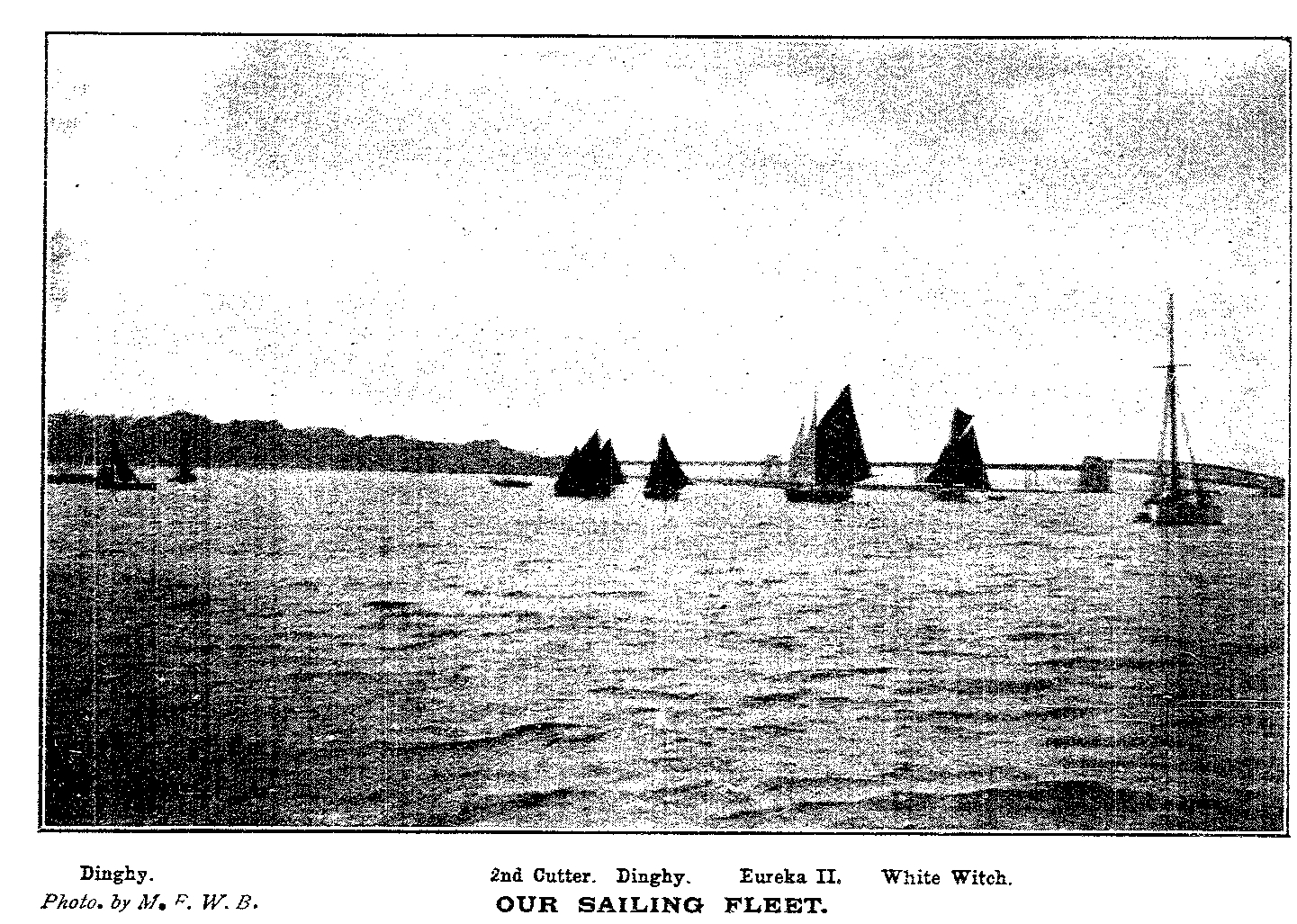SMALL BOATS
Admiralty Class Sailing Dinghies (1940s to 1954)
There were three of these clinker built
gaff rigged boats. They were replaced by the MSODs fro Moody Cup races
from Summer 1952 but remained as rather dilapidated general sailing
boats.
Alaunia (1947 to 19??)
Aboard
the Conway Captain Hewitt kept a beautifully varnished mahogany sailing
dinghy named Alaunia. The Admiralty purchased the former Cunard White
Star liner Alaunia in May 1944 to become a depot ship stationed at
Devonport. The shipwrights aboard Alaunia at Devonport made the sailing
dinghy and her captain, an old Conway, donated her to the Conway in
about January 1947. The 14 feet boat was an unusual design and proved
difficult to sail. Occasionally senior competent dinghy hands were
allowed to sail her in the Strait. Her hull constructed of wafer thin
diagonal mahogany strips hand sewn with copper wire, was a masterpiece
of the boat-builders' craft.
Bourne Dinghys (1970 to 1974?)
Six boats were purchased with sail numbers 8233-5 and
8431-3. It is thought they were handed on to the Conway Centre in 1974.
Cariad (1904 to 09) Image in Image Archive Sailing album
Sailing
yacht on the Mersey owned by the Chief Officer (Lt H McNeile-Dibb RNR)
on the Mersey. Used by the cadets for sailing. A one rater, 28 feet,
half decked, centre board boat. All racing was all for cash prizes and as Cariad had won more than her value her handicap was greatly increased leaving her unable to win more prizes so she was replaced by Water Witch in 1909
Cutters 10 oared (1865 to April 1905)
After
a long and hard life at the hands of Conway cadets the Ship’s two black
and white, ten oared cutters were found to be beyond repair and were
cremated in the furnace. Some 4,000 boys had learned to row in them and
it was estimated they must have covered over 100,000 miles.
Cutters 12 oared "Bombay Cutters" (May 1905 to 1920)
The
1905 10 oared cutters were replaced by two twelve oared cutters made of
teak in Bombay Dockyard. They were a matched pair; 30 feet long by
eight feet four inches beam, stepping two masts with a dipping lug
forward and a standing lug aft. Photos of the cutters are here.
In April 1910 The cadet
announced that the "2nd cutter" (assumed to be one of the Bombay
Cutters) had been rigged with a false keel and was used mainly for
sailing. Rigged as a ketch she carried about 360 square feet of canvas.
her rudder was enlarged.
"Cutter" 16 oared (1883 to 19?? - at least 1910)
Useually
known as the Barge she was built 1883 but simply hung on the davits and
never used because her thwarts were too close together. In April 1910
she was altered to row 12 oars and was renamed the 3rd Cutter and used
routinely with the others. Photos of the cutters are here.
Cutters 12 oared "RNVR Cutters" (1920 to 1926)
The
Cadet magazine for April 1920 (page 93) records that the previous
"working cutters had been broken up" and replaced. The new boats were
RNVR cutters that had been stored in Williams Yard at the top of Rock
Ferry pier during the war. They were overhauled and "are quite
excellent boats". There was a separate sailing cutter at the same time. Photos of the cutters are here.
Cutters 10 oared (1926 to 1941 at least)
The
previous cutters were replaced by a pair of matched ten oared cutters
specially built for the Ship.The design was prepared by the Ship's
carpenter Mr Williams. They were constructed by Rutherford & Co,
Neptune Works, Birkenhead. They were delivered early in the Easter
Term. They were made from the same mould and so were perfectly matched
for rowing races. They had a fair turn of speed. They were constructed
of well seasoned timber and copper fastened throughout, weighed fifteen
hundredweight, were 27 feet long, 7 feet beam with roomy bow and stern
sheets. They were no longer around by 1953. Photos of the cutters are here.
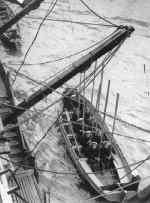
Click image to enlarge
Cutter Heavy Duty (at least 1940s)
This was a single 12 oared cutter used when water was too rough to use a motor boat. Photos of the cutters are here.
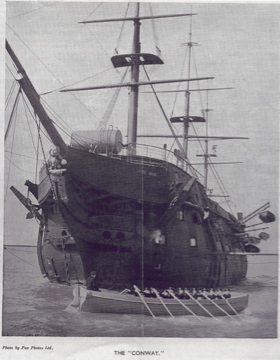
Cutters 12 oared (19?? to 1974)
There
were two 36 foot, 12 oared cutters in 1941. There were six rows of
thwarts, each with two oars, one for each side. A cadet manned each oar
so there were two oarsmen per thwart, their feet on wooden stretchers
to give purchase when rowing. Oars were held with both hands, inboard
hand on the loom, outboard hand on the oar shaft. Oars were named,
reading from aft, port and starboard, stroke, second stroke, bertha,
second bertha, second bows and bows. Photos of the cutters are here.

They
could also be rigged for sailing using the de Horsey rig. This has
short spars and snug sail and mast-plan all inside the boat, a mainsail
with perpendicular leech that is boomless for quick handling, and a
jib. They were heavy boats but went well in a strong breeze. "There
were two sailing-cutters, heavy gaff-rigged wagons with loose-footed
mainsails controlled by a sheet running through a murderous block. They
had centre-plates on tackles, and were heavily-rigged. The sails were
No.2 canvas, which seemed to be woven from steel thread when wet, but
they sailed well in a stiff breeze, when it could take two cadets to
hold the tiller up against the constant tendency to fly up into the
wind. They were totally safe, even when driven hard on the wind with
the lee gunwale under and green seas pouring in: junior cadets enjoyed
the privilege of doing the pumping, often enough driven to superhuman
efforts by sheer terror.”
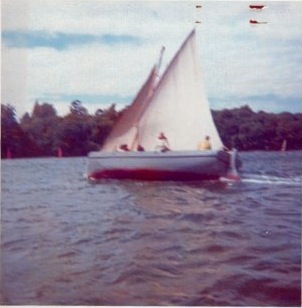
“Dolly-Tub” see Water Boat (Mersey) (9th March 1908 to 1913)
Emergency Boat (1960s)
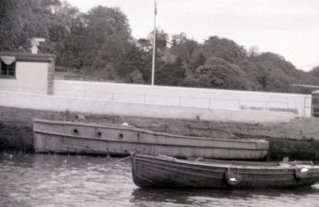
Normally moored on an outhall in the dock. Photos are here.
"I distantly recall
that it was gray, maybe 4 oared with a rudder & was manned during summer
sailing sessions but I may be wrong in that. The out haul was used for
adjustment to allow the boat to be kept afloat at the lowest of tides
by heaving it out via a continuous heavy warp led through a submerged
pulley at the outer extreme of low water. A further pulley on the
dock wall just SW of the lifeboat allowed it to in hauled to the dock
wall at high tide to negate the need for a tender to access it."
"I also seem to remember that it had copper buoyancy
tanks under the seats?"
Eureka (at least 1904 to Summer term 1908) Image in Image Archive Sailing album
Sailing
yacht owned by Captain Broadbent on the Mersey. 25 feet long,
half-decked with a centreboard. Used by the cadets for sailing. Fitted
with a lug in 1908.
Eureka II (Summer Term 1908 to 10) Image in Image Archive Sailing album
Large
sailing yacht purchased by Captain Broadbent from Barrow in Furness for
use on the Mersey. She was 36' long with a 10' beam and drew about 4'
6". Her cabin and focsle were "roomy and airy". She was raced and took
parties of cadets on extended cruises during the Summer holidays, Sister to White Witch?
Fifes (1955 to 1974)
In
1926 Messrs. W. and R.B. Fife of Fairlie were asked to draw up plans
for a new class suitable for the waters of the Conway estuary and Menai
Strait. The waterline length to be limited to 16ft. and the maximum
draught to 3ft.- 3ins. This was done; the length overall being 24ft.-
4ins., with a beam of 6ft- 6ins. and an 18cwt. lead keel. Fifteen were
built by Messrs. A.M. Dickie & Sons of Bangor, and all but one are
still in existence. In 1933 the cost of a single boat was £275
complete, which included a £5 royalty to William Fife. An original Fife sold in 2015 for £28K!
Conway
cadets first raced the Fifes on 29th September 1948 when No 2 Morwys,
No 4 Deryn Gwyrdd, No 10, Beryl, No 11 Medrys, No 12 Coralie and No 15
Nestor were very trustingly leant by the Fife Association of Beaumaris
to Conway for the cadets to race. No 5 Thelma, No 9 Kookaburra were not
available at the last minute. The race was won by Morehead in Morwys.
Thelma
was a gift to the ship in 1955 by Mrs Mabel Lynton-Vicars the mother of
the late Mostyn Vicars, a well known offshore sailor. Sail number 2 was
2 Morwys with a white hull. Sail number 5 was Thelma and had a red
hull. Photos of the fifes are here.
"s
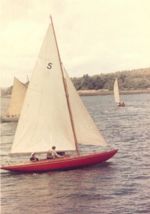
Thelma - Click image to enlarge
I'm
pleased to report that Fife No. 5 (Thelma) is alive and well, having been
lovingly restored by Bill Thompson (58/61). She has been acquired by
another Old Conway - T A Kershaw ('Tak') who lives in Beaumaris.
(April 2014) Morwys
was beautifully restored, sold and relocated to Salcombe where she
remained for some years. She has now been sold to a gentleman in
Switzerland and is sailed on one of the Swiss lakes.
All
but one of the originbal 15 fleet of Fifes are still raced by the Royal
Anglesey Yacht Club. They are now called 'Conwy Fifes' - http://www.royalangleseyyc.org.uk/Racing/Fife.htm They have adapted the Conway ensign as a burgee.
Firefly
There was one of these14 foot boats in the early 1940s.
Flame (December 1959 to 19??)
The sailing boat Flame was purchased for £1,800.
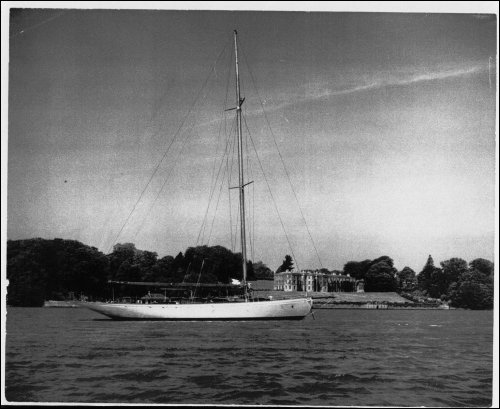
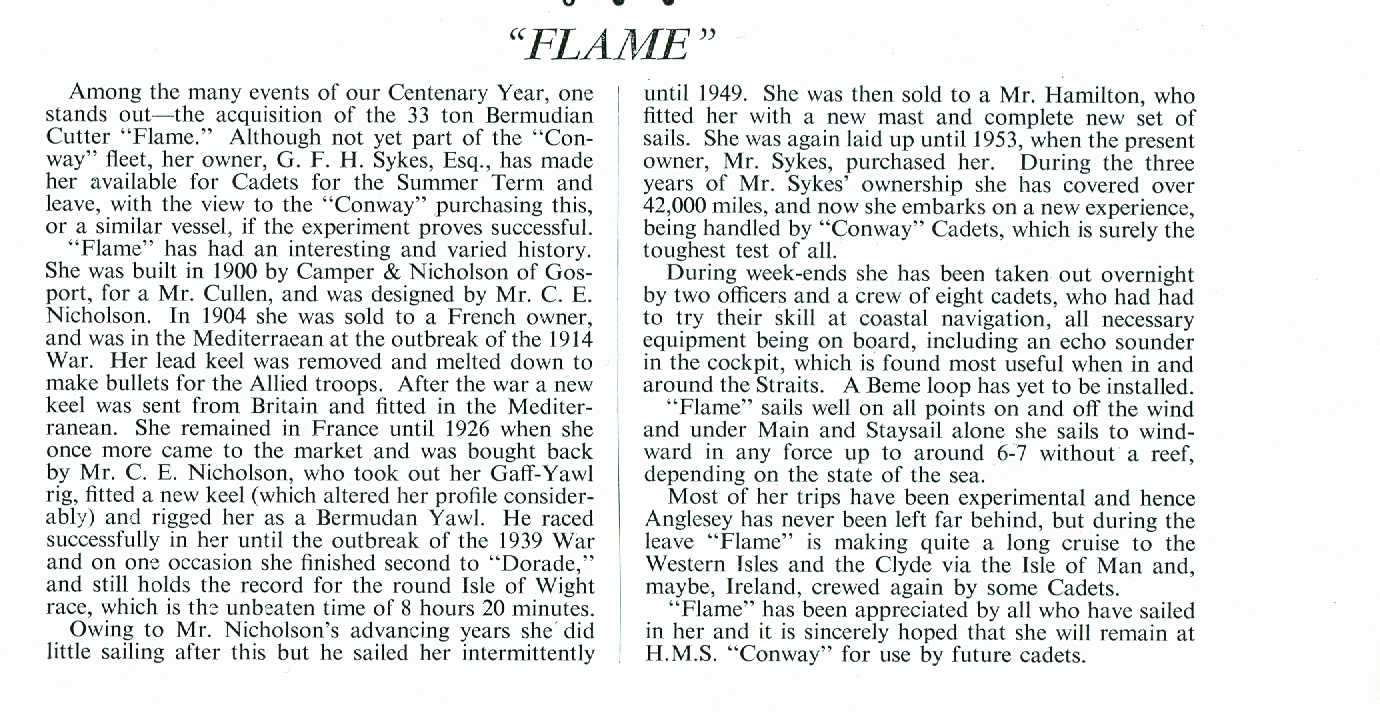
Garibaldi (1940s)
Outward Bound's ketch was sailed by Conway cadets attending courses at Aberdovey.
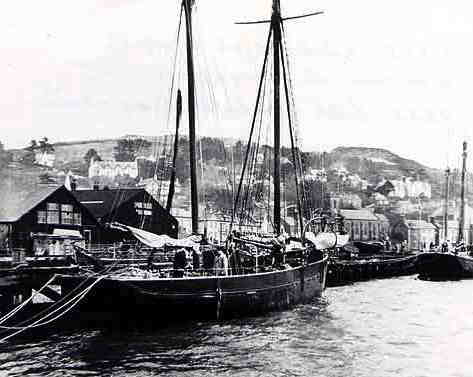
"The
Garibaldi was laid up at Aberdovey when I was at the Outward Bound Sea
school there in 1952. We had to pump bilges every day as she was
leaking badly,"
"understand
she was sold to a Caernarvon company for further trade but on passage
sprang a leak and put into Pwllhelli were she became a wreck. She was a
French fishing boat renamed Garibaldi in 1941."
"I
was at school at Pwllheli 1954-55 when the Garibaldi was tied up in the
harbour. She was there for a few years before they moved her to what we
used to call the island on the other side of the harbour, she was sadly
set on fire and that was the sad end of Garibaldi."
Gig - Tthe Ginger Bread Boat" (1912 to 19??)
This
was a replacement for the skiff Mina. Described as a a “brown six oared
gig” and reserved for use of Mizzentopmen. She was purchased form "the
Daimler crew".
Gigs (1928 to 1956)
This pair of six oraded gigs was
commissioned from Messrs Winram of Liverpool by the Conway Club in 1928
for the renewed Conway - Worcester boat race. Gig races on the
Mersey, depending on the stream, were raced from Bromborough Lock gates
to the Ship - 1.25 miles, or from Cammell Lairds to the ship - 1 mile. Photos of the gigs are here.
Gigs (Jul 1956 to 1974)
By
1956 the 1928 gigs were beyonfd ecenomical repair so a new pair was
commissioned from Dickie's and they were depivee3red in July 1956. Photos of the gigs are here. Many
of us will remember many hours spent rowing these six oared gigs and
competing for the Barnes Trophy (as stroke of the Fo'c's'le gig in the
mid 60s I seem to remember it was virtually our trophy).
At Plas Newydd races were always from off Port Dinorwic.
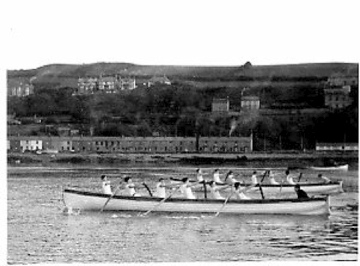
What
happened to the gigs is a long story with a sad ending. In 1974 when
the ship paid off the gigs, with other things, were given to the
Indefatigable. In 1995 Indefatigable also paid off and all her property
was set to be auctioned. Haydn Lockwood (46/47) who lived locally
decided to see if the gigs could be reclaimed and used in some way,
even though they were in a pretty poor state. A surveyor thought one
might be restorable but that the other was beyond economic repair.
Haydn went to see the receiver, told a good tale and was given 24 hours
to remove them. “From memory our Gigs were 32’ loa and just under 5`
beam so we had problems finding a suitable wagon so we used a static
caravan transporter instead”. He recruited friends, OCs and a probation
officer with a gang of lusty lads and packed them of to safe keeping in
Birkenhead. Haydn started to raise money for their restoration,
including seeking government initiative funding, although eventually a
private donor said he’d fund the work. Haydn had to go abroad for 6
months and although the gigs were in a secure site when he got back
they had disappeared. “I made some discreet enquires and decided that
nothing would resurrect them and too much enquiry could muddy the water
for other worthwhile projects. A sad ending although what we could have
actually done with them is debatable” as they were in such poor
condition.
Captain's Gig (19?? to 1974)
There
were three 18 foot oars each side and they called for considerable
strength because of their length and the narrowness of the gig. The
oarsmen sat one behind the other. Steering was by yoke and lines and
took some little time to master. Photos of ther gig and her crews are here.
International 18
The
International 18 was acquired prior to 1954(also a gift). "I think it
might have been called Puff, the class raced at West Kirby and the Isle
of Man."
Inknoo (Circa 1908)
Image in Image Archive Sailing album
A
7 ton cutter, owner by the Chief Officer's (Mr Dibb) brother. Used for
racing and sailed each year in the Menai Strait regattas.
Inyala (May 1911 to 19??) Updated!
Image in Image Archive Sailing album
A
20 ton sailing yacht - looked very like Eureka II. She was an
"auxiliary cutter" and was bought from Rowland's yard at Bangor. She
was 48' overall, 11' 9" beam and carried 1,450 square feet of sail. She
had a Smart & Brown paraffin motor capable of 5 knots. In 1912 she
was altered to yawl rig.
Joan (1941 - 46ish)
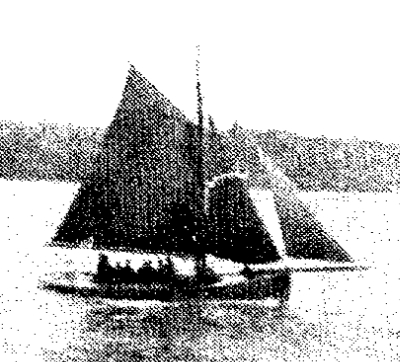
In after the ship had arrived at Bangor 1941 Mr. Lawrence Holt, chairman of the management committee,
presented the Ship with Joan, a Morecambe Bay Prawner aka "Nobby" and this is the name she was often given. Joanwas
a six ton, 25 foot by 9' 5", strong sailing cutter
with an 18h.p. engine and a draft of 4' 6". Her small cabin
could sleep two. Her sail plan
consisted of a gaff mainsail, staysail and jib. She was still fited
with her trawling gear. She was very popular addition
but seems to have disappeared from the Ship by 1946. The
Cadet magazine (Oct 1941 page 178) says she was a "pretty looking
craft" that "sailed like a witch". On her first outong, beyond Puffin
Island, manned by cadets the trawl was used but netted only a single
crab and a gurnet. The engine proved most unreliable.
“Groups
of cadets would sail Joan into Beaumaris Bay in the summer months,
sometimes entering the River Conway and mooring near the castle. I
recall an occasion when she grounded on a falling tide whilst making
for Conway and, being deep-keeled, she ended up high and dry on her
side on the sandbank. There was nothing for it but to wait patiently
for the tide to turn and float her off.”
“I remember a real experience
of the sea in the nobby Joan. A lovely summer’s afternoon, just a
gentle breeze. A crew of about six with an officer in charge, we gaily
set sail, clad in short-sleeved summer shirt, shorts and canvas shoes.
We had a marvellous day just mucking about in boats. Returning to
Bangor the heavens opened, rough seas, high winds and torrential rain.
We had no extra clothes whatsoever. I have never been so cold in my
life. That certainly taught us a lesson!”
Juice Barge see Water Boat
Lifeboat (1950s - 60s)
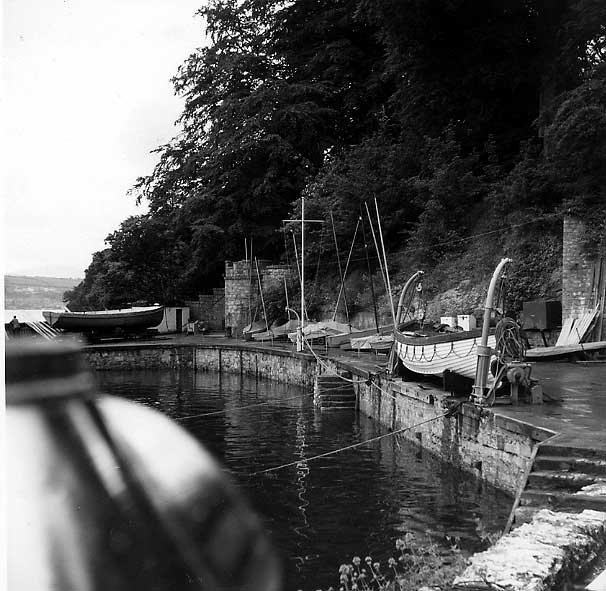
This was normally in the large davits on the side of the dock at Plas Newydd. It never seemed to be used.
Lightning
There was one of these in the early 1940s.
MSOD (Menai Strait One Design) (1954 to 1974)
The
MSODs (Menai Strait One-Design), were 20 feet long, built out of
mahogony on oak frames, clinker built and half decked. Rumoured to be
uncapsizeable. The first three MSODs purchased in January for the Summer Term of 1952 were numbered and
named , 8 - Derwent (later renamed Taeping), 17 - Playmate (later renamed Ariel and Rona (later renamed Thermopylae). The funds were provided by The Marine Society. A fourth MSoD was purchased for the Winter term 1952 and given the name Lightning, number 18. At some point 10 - Sobroan and 2 - Flying Cloud were purchased but the dates are not known.
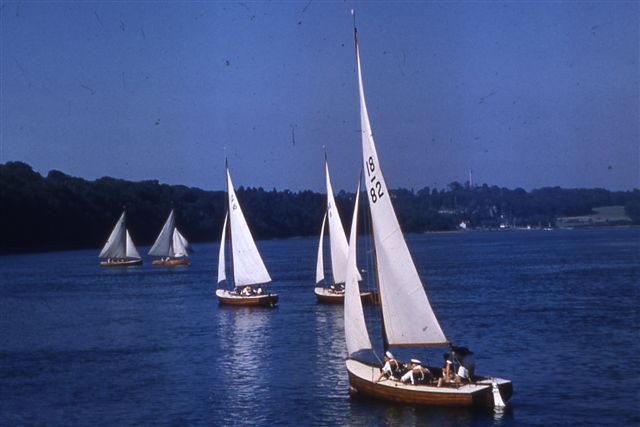
“They
were super boats – half-decked, carvel-hulled Bermudan sloops – that
put up a good performance without threatening to drown their crews,
they were all but impossible to capsize."
Photos of gther MSODs are here. There is a great web site at http://www.msod.org.uk/ learn what happened to them all and add your reminiscences.
Motor Boat (?? to Feb 1895)
No details are known other than this boat was crushed and lost in th Mersey ice in Feb 1895.
Motor Boat "The Launch" (1895 to, at least, 1905)
The
replacement for the motor boat crushed in thr Mersey ice in Feb 1895.
Refered to at first as the steam launch. She was extensively repaired
in the Easter term of 1905 making her "quite a respectable looking
craft".
Motor Boat (June 1914 to ??)

In
June 1914 a 24' long open motor boat was acquired. She had a beam of 6'
6" and was fitted with seats all round. The engine was a 2 cylinder
Daimler with ideal Reserve Gear, and was powerful enough to tow the
unpowered water barge.
Motor Boat No 1 (1919 to Summer 1926)
A
"new motor boat was purchased by the Ship in 1919 to replace the
original pinnace. She was built by W H Roweland & Sons at Bangor as
a motor sea fishing yacht. She was 31' 6" long, with a 7' beam. After
one season fishing her builders bought her back, added a new 2hp Brooke
Motor and sold to Conway. She motored round from Bangor to Rock Ferry
under her own power. She was judged "a very fine able boat with ample
power and speed for our needs". She was damaged beyond repair in the
summer of 1926 when a Dutch vessel collided with the Ship.
Motor Boat No 1 (Oct 1926 to 1974)
A
replacement No 1 was commissioned from Messrs Rutherford & Co,
Neptune Works, Birkenhead as they had done such a good job with the new
cutters. The cadet magazine Dec1926 page 67 describes her as "a
handsome, roomy, able looking little vessel 30' long, 8' 3" beam and a
a 20 24 Ailsa Craig engine pushes her along at a good 8 knots. The fore
part fro 12' 6" from the stem is is roofed over with a teak wood
covering to form a cabin and the sides of this roof have a tumblehome
of 45 degrees, which quite precludes the the top of the house hitting
against the gangway or ship's side in bad weather. She carries 60
cadets easily without any noticeable difference in draught, and is dry
and comfortable in a sea way - the ideal boat in fact for the service
for which she is required. Her hoisting weight is just four tons."
No. 1 had tiller steering. She started on petrol and when warm enough turned over to TVO. Photos are here.
“No1 boat had a Ford son engine during my time (1949-51).”
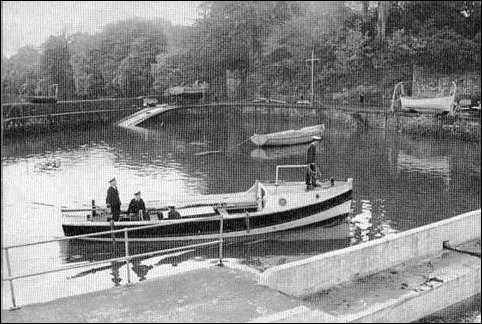
“In 1961/2 the process was: Correct with the ether. Pump up the compression, open the tappet
ports, squirt in the ether, release the compression. Failure. Have a
fag. Repeat operation, maybe with just a little sniff. Always started
second time.”
"I
remember sometime during my tenure at Conway (68-70) No1 got a new
engine straight 6 diesel I think and it went very nicely a lot nicer to
start than cranking over the old petrol/TVO engine."
Thought to have been transferred to Indefatigable. Current whereabouts not known. Anyone know what happened to No 1?
Motor Boat No 2 (approximately 1919 to 1974)
Could
not have been acquired before 1919 as that is when the original pinnace
was replaced by a new motor boat which was designated No 1.
She
was fitted with a new Brook's 8-10 engine in December 1924 - she still
had her original Brook's engine dating from April 1917. It was
estimated it had run some 40,000 miles. Photos are here.
"She was steered
with a proper wheel, whereas No. 1 had tiller steering and a petrol
engine. No.2 was also a lot smaller." She started on petrol and when
warm enough turned over to TVO.
"No.2 had a close coupled
forward / reverse gearbox with direct drive. I'm not sure of the
starting but I presume that it was a crank handle."
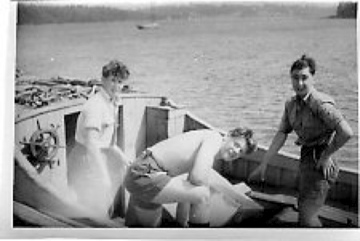
"I
was one of No.2 Boat’s engineers and she ran on TVO (Tractor
Vapourising Oil). No. 2 started on petrol and after the engine warmed
up you had to switch over to TVO. The petrol was in red jerry cans and
the TVO in green. The two fuel tanks were placed on each side of the
hatch to the cabin in the focsle. The TVO pump stood on the dock near
the lifeboat. (which was launched every now and promptly sunk to the
gunwales). I used to keep a log of fuel usage and I recall there was a
bit of a competition between the various engineers as to the least
petrol used. This sometimes meant turning over to TVO too early and the
engine stalling much to the chagrin of the cox especially if coming out
into a strong tide."
“No2 boat had an Ailsa Craig diesel
engine(1949-51). It had a big heavy flywheel on the aft end and a
compression release handle. Handle was put over to no compression the
engine was then turned over at speed, then handle was put over to
compression. The weight of the flywheel overcame compression and away
it went. I think it was a 3 cylinder engine.”
“In 1956-7 we did use ether to start the engine in the cold
weather. Also, if you remember we had to hand crank a compressor to use
compressed air as a starter. This was released into a cylinder which caused
the engine to turn over. If you were lucky and with the ether, it fired
first time, away you went.”
“
'Armpit' the ex RN Tiff used to demonstrate an alternative starting
technique utilising a lump hammer and a blunt chisel on the flywheel.”
In
1971, a Conway cadet whilst an engineer cadet at Birkenhead Technical
College spotted the engine from No 2 motor boat in the college
workshops. The crack in the entablature was instantly recognisable.
No 2 is thought to have been transferred to Indefatigable. Current whereabouts not known. Anyone know what happened to No 2? Please email me.
Pinnace (1905 to 1919)
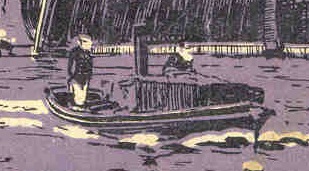
The original pinnace was an ex RN steam powered boat, one of 634 built.
The image above is by Shoesmith from the cover of the Cadet magazine. There are more images here.
Although the images are not clear she seems to have had a open stern
with tiller steering, a central engine room/funnel and a forward
cabin.She was acquired in December 1905 and her tall thin funnel was
immediately replaced with a shorter wider version. She was disposed of
in 1919 and replaced by a "new motor boat".
Pinnace (1946 to 1970)
This pinnace came to Conway by a circuitous route from the German
Kriegsmarine at the end of world war 2, a gift from Alfred Holts. Glen
Line was having a ship, the Glen garry, built by Burmeister and Wain of
Copenhagen. She was launched in 1939 but never delivered because of the
war. When the Germans invaded they commandeered the unfinished vessel,
renamed her Meersburg and gave her to the Hamburg-Amerika line where
she served first as a U-boat target ship in the Baltic for the 27th
Flotilla. Later she was ordered to Rotterdam and then Hamburg to be
converted into an Hilfskreuzer or auxiliary cruiser (armed merchant
raider). She was to be raider number 5 and named Hansa. Details
of Hansa can be found here:
http://www.geocities.com/pentagon/2833/kriegsmarine/raider/hansa/hansa.html
Although commissioned in 1943 she never sailed. She participated in the
final desperate evacuation at Hela until the end of the war, sustaining
damage when she hit a mine on May 4 1945 and sank. She was raised later
in May 1945 and renamed Empire Humber. Holts, reclaimed her in 1946
through the extraordinary guile, tenacity and sheer insubordination of
their chosen representative Captain Frank C Brown. He, thwarting the
best efforts of the Royal Navy, which, considering her to be a
legitimate prize, "arrested’ the vessel in the name of the Admiralty
and ordered her to remain in port. Brown simply upped anchor and stood
out to sea. "No shots came across as we passed the Needles. We had no
pilot to dispose of - we did not stop. So we came to buoy 10 at
Gareloch. From that day to this, I have heard no more of my
infringement of maritime law. I assume that my juvenile delinquency was
overlooked in the confusion of those days". She traded as Glengarry for
the Glen Line for many years before transferring to Ocean in 1970 as
Dardanus returning to Glen Line in October 1970 for her final trip to
the breakers at Tadaju, Japan in March 1971
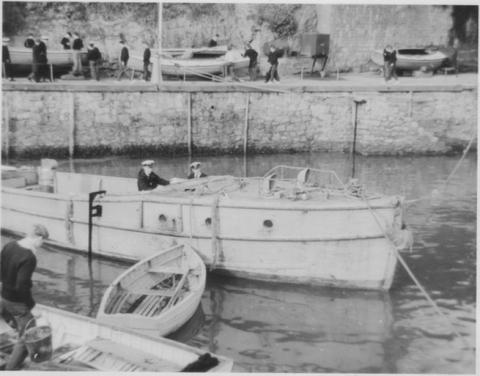
The
pinnace was one of standard class of Kriegsmarine small
support boats. There
were three version. Ours was one of the largest types - 11m Admiral's
and Captain's launches (called Chefboote, or Admirals und
Kommandantenboote) - they had three portholes. Many were fitted with a
small canopy. Capital ships like Bismarck, Graf Spee, Admiral Scheer
and Gneisenau carried three. Next were the smaller motor launches
(Motorbarkasse, Motorpinasse, (Zerstörer-Pinasse) with two portholes.
Finally were the small Motorjolie with a single porthole. Most had
small enclosed cabins with an open steering poistion.They two smaller
versions were carried even in small vessels like minesweepers. Wartime footage of other raiders including the famous/infamous
Atlantis and Pinguin clearly shows sisters to the pinnace being used
to ferry men and materials between vessels at sea. A selection of photos can be found online (http://www.ship-model-today.de/sd126.htm is good for the 9.2m version) and in books is below (left Admiral Scheer, centre Prince Eugen, right Geneisenau).
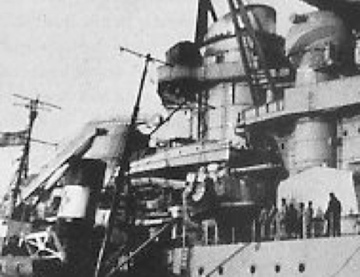 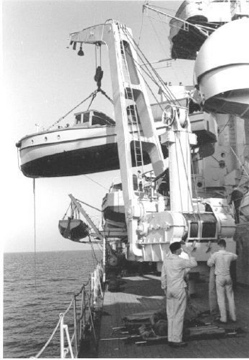 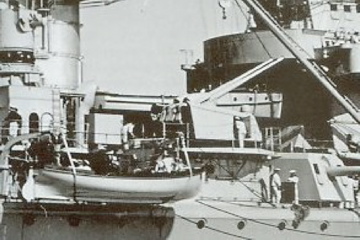
The
pinnace was superfluous to Holt’s needs so they donated her to Conway.
Sister pinnaces went to the Holyhead and Liverpool Pilots. An OC
reports a similar boat operated by the German police out of Cuxhaven.
Another OC recalls one in Portsmouth harbour for many years.
"When
the pinnace was delivered to the ship in 46 by sea from Birkenhead
she still had her original engine and transmission. She had I think a Mann diesel
and conventional transmission, the "gear stick " was rather
like and old hand brake lever with a release that locked it in position.
There was a plate on the E/R bulkhead which said in German that it
had a capacity for 85 persons in fresh water. In 1950 as a callow
3rd mate leaving Hamburg in the Dymas we had to radio ahead to Cuxhaven
to request the police to collect some stowaways, the police came out
to meet us in the twin of the pinnace! On the pinnace it was possible
to see where lifting points were fitted so she could be lifted on
davits."
When delivered
to Conway she had a conventional rudder. In 1949 or 50 she was fitted
with Kitchen Gear, more correctly ''Kitchen's
Patent Reversing Rudders'' It was patented in the U.K. and Abroad
under British Patent 3249/1914 ( Which may have been reference to
the year ) by Gordon H. Fraser 747 The Liver Buildings, Liverpool.
The modern steering unit by waterjet is a derivative. This
made her very manoeuvrable. The following is an extract from "Basic
Naval Architecture" by Barnaby:The
Kitchen rudder consists of two curved blades carried on pivots above
and below the propeller. Normally, the blades lie on either side of
the propeller, but they can be angled to the race to give steering
effect, or they can be closed together behind the propeller to form
a sort of hemispherical cup that enables astern way to be obtained
without the necessity of reversing the propeller. This may sound like
"hoisting yourself up by your shoe- strings", but there
is an actual astern thrust of the order of one third of the normal
amount. This suffices for ordinary manoeuvring as the closed blades
provide an efficient brake.” Other settings allowed quick and fancy manoeuvres. Cadets who could
master this complicated arrangement (many failed miserably) could
do anything with the pinnace! “I found that especially when
stemming the tide that by using the kitchen gear/rudder the boat would
very near go sideways. Great fun and when executed with some panache,
then very spectacular coming alongside. When driving one of HM Minesweepers
later in my career the previous experience stood me in good stead,
Happy days!!”
“There
was a plate on the engine room bulkhead, which said, in German, that it
had a capacity for 85 persons in fresh water. It was possible to see
where lifting points were fitted so she could be lifted on davits.”
Timed in both directions over a measured mile between Gallows Point and
near the Gazelle her speed was 11.5 knots. She was to be a very welcome
addition to Conway’s trio of motorboats. The two motorboats were the
long suffering workhorses, the water boat had her dedicated and vital
role, now the pinnace provided a greater carrying capacity and power.
She was fitted with a small binnacle and used for navigation lessons.
The pinnace, like all Conway boats was to suffer many and varied
indignities at the hands of cadets over the next 30 or so years. Each
boat had a coxswain in charge (always a cadet captain), and a bowman
and stern man to handle lines. A cadet was also assigned as the
engineer to nurse the engine; the term engineer being used somewhat
advisedly! "The starting routine even more special. There was a long
steel lever that had to be cranked back and forth to build up pressure
in the firing cylinder, which would then be released by pulling upwards
on a short handle at the side of the engine. In cold weather liberal
applications of ether spray were also required."
"The
Pinnace was an unusual boat. She had a diagonally lapped carvel hull
and was copper sheathed on the outer hull. The reason I remember the
hull structure is that the Pinnace leaked quite badly especially at
speed and you could see the water weeping in between the laminations."
She suffered many indignities over the
years including several beachings at PD and one incident in 1959 when
she was holed in the starboard bow (Cadet Schunck denies all knowledge
of that incident). She survived all that cadets could throw at her
and her into. There are various rumours about the final fate of the
pinnace including being scuppered under the tubular bridge (complete
with Brookie in tears), being burnt in an accident and sold. The truth is more prosaic.The
pinnace had been built with iron nails and these were continually
being replaced as they corroded. The decision was taken in the summer
of 1970 to scrap her as she was beyond economical repair. She was
beached in the dock, stripped of fittings and a working party ordered
to set fire to her. "The party consisted Rob Tubb along with
Mike Holyoake, "Oris" Dean, John Hopkins and I think Robin
Povall SCC Mizzen was in charge. I do recall we had great difficulty
setting her alight, mind you we were using TVO!!!" Nick
Goodwin remembers her coming out of the water onto the slip: “I
lost the top of my little finger to the starboard leg we were attaching.
I remember picking it up and putting it back on the end and
going off to see Sister Jones and being taken off to Bangor Hospital.
It knitted back on but never grew to match the rest of the finger.
So I missed the firing of the wooden hulk." "One
summer leave the remains were picked through by one of my term mates.
He collected all the bronze/brass fastenings and maybe the bronze
buckets. Will not name names but recall being shown the nails."
Photos are here.

Prince Louis (1944)
Outward Bound's schooner was sailed by Conway cadets attending courses at Aberdovey.
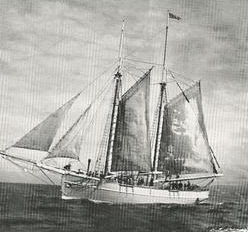
Some believe she is still afloat as the Bel-Espoir but the details on this web site show Bel-Espoir was purchased by Outward Bound as a replacement for Prince Louis 1 (above) and became Prince Louis II.
Rivers Class Dinghies (1911 possibly to 1935) Image in Image Archive Sailing album
These were purpose built 18’ centre board dinghies built at Appledore.
They were paid for with the proceeds from the cadets' Canteen. The
first two named Tor and Torridge were first raced July 1911. Two more
were added later that year. Eventually there were a fllet of six.They
were raced in RYMC races and had reed sails.
Sea Mouse - Dinghy
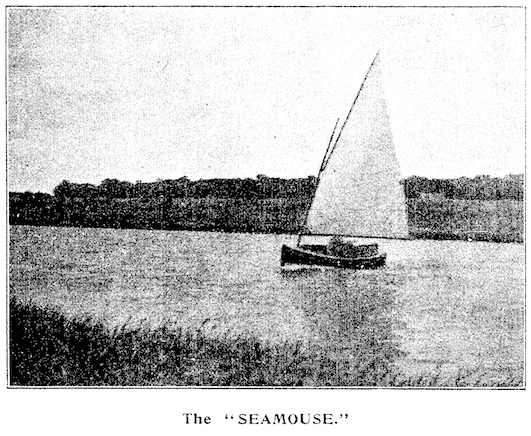
The 10' centreboard dinghy Seamouse was aquired early in 1926. She was described in The Cadet magazine as a "roomy weatherly little craft" built by her previous owner for use weekend cruiising on the Humber. She toook a crew of two.
Skiff 1 - "Mina" (19?? to 1912)
The skiff "Mina" was declared unsafe. She was replaced by the "Ginger Bread Boat".
Skiff 2 (19?? to 19??)
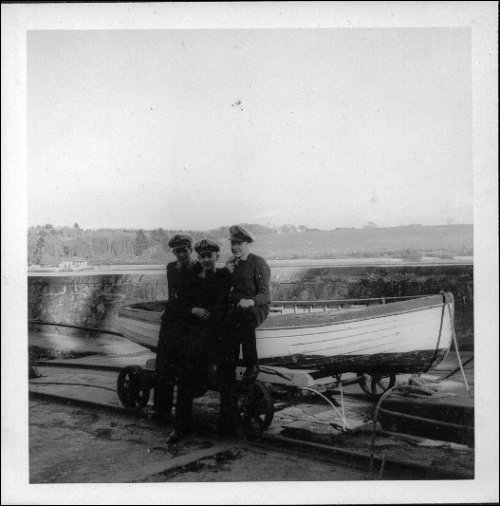
A skiff can be also seen in the photo of the pinnace above.
"I remember as
being slung on lightweight davits on the Dock wall on the PD side
virtually above the slipway - I think it was the only varnished boat
apart from the MSODs."
"The skiff was still there in 51-52. On one occasion a disgruntled
cadet used it to run away from the ship. I cannot, however, remember
the consequences. On another occasion, a personal one, after putting
a MSOD dinghy ashore on a falling tide, I and the
other crew member had to use the skiff to row out after lights out to
the dinghy, wait for the tide to refloat it and then tow it to the
mooring buoy using the skiff and then return to the ship. There we
had to hoist the skiff and then stagger down to the orlop deck and
collapse into our hammocks. It was a cold and rainy night and there
was no shelter neither in the skiff nor the dinghy and it was about
2230 before we were able to get ourselves back to the ship, wet cold
and extremely 'cream crackered' as Rob Tubb would say. It certainly
taught us a lesson about going ashore on a falling tide; though I
must admit to doing it with small boats a couple of times later in
life. Who lives must learn."
Warspite (1940s)
A motor sailing ketch used by Conway cadets attending Outward Bound at Aberdovey in the late 40s and early 50s
Water Boat (Mersey) (Monday 9th March 1908 to 1913)
Named
the “Dolly-Tub” and described as a “barge type of vessel”, 32’ long,
beam 9’ and depth of 4’ 6”. Copper bottomed fore and aft to 8” above
the light-load water-line. Fitted tanks that could carry 2,130 gallons
which took Conway’s pumps one and a half hours to pump into the ship.
The tanks could be lifted out so she could carry all the sea chests or
a large number of cadets.
Water Boat/Barge (Mersey) 1913 to 21st May 1941)
When
Conway left the Mersey for the Menai Strait the water barge was taken
along: "The water boat had been towing alongside the port gangway, but
when we got into the channel it was found to be too rough to keep it
there any longer. First, one of the tugs was slipped and detailed to
take the water boat in tow when we set it adrift. The tug picked it up
after some trouble, but was unable to keep up with us. As the water
boat was shipping a good deal of water it was decided to leave it with
one of the balloon barrage ships anchored along the channel. It sank
later that night." It was not recovered.
Water Boat (Menai Strait) (June 1941 to 19??)
Following
the loss of the original water barge and after a few weeks searching
Conway acquired Indefatigable’s redundant water boat. As Indefatigable
cadets had moved ashore permanently due to the air-raids, they were
disposing of their ship, boats and equipment. The boat was named the
Arthur Bibby (the Bibby Line family were major sponsors of
Indefatigable, as Blue Funnel’s Holt family were for Conway) but cadets
generally called her the ‘juice barge’. She was built in 1932 by The
Enterprise Small Craft Co of Rock Ferry. She was 36' long, 10' broad,
had large water tanks capable of holding 1,800 gallons of fresh water
and had a very low freeboard had. There was no cover at all on deck;
the cox’n stood right aft with a wheel driving chains to the rudder.
With a 30 hp Kelvin engine she was not particularly manoeuvrable due to
her weight and low power.
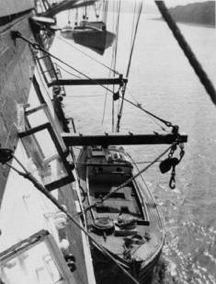
She was towed part way from the Mersey by a coaster but made most of
the transit under her own power. “When we got the boat, it was greatly
admired and appreciated by all! It actually had a telegraph to signal
the ‘engine room’, which gave the cox’n a fine sense of being in
command of something worthwhile.” The engine room was usually full of
tobacco smoke! “The engine was an absolute sod to start using a
starting handle which required a particular swing to make it kick in,
and could break your wrist if it backfired.”
Photos are here.
Whalers (June 1914 to 19??)
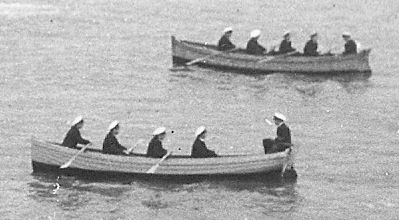
In
June 1914 the Recreation & Canteen Fund purchased two 17.6" long
whalers purely for recreation purposes and for the summer months only.
They were for use by "mizzentopmen and other smaller boys". They are
the two in the photo above. They appear still to have ben in use in
1932, and one may even have survived as the Emergency Boat (see above)
in the 1960s.
White Witch (1909 - 1910) Updated!
She was purchased by the Chief Officer, Mr Dibb, and his brother in 1909 as a replacement for Cariad. Described as a 6 ton cutter. Her first race was on 6th June: "a stiff little craft ... her crew thought her rather wet" She is second right above. She and Eureka II
may have been sisters as they were both entered in Tranmere Sailing
Club's Class A race on 28th Sep 1910. They also seem to have very
similar rigs. She did not comptee much although in 1909 she won second
prize in ther B class, taking three seconds and one third. Mr Dibb
hoped she could do better and was sold later in 1910 when the Dibbs
bought Dawk Eeaing.
|
